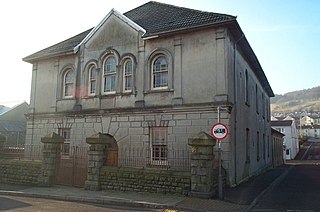
Aberdare is a town in the Cynon Valley area of Rhondda Cynon Taf, Wales, at the confluence of the Rivers Dare (Dâr) and Cynon. Aberdare has a population of 39,550. Aberdare is 4 miles (6 km) south-west of Merthyr Tydfil, 20 miles (32 km) north-west of Cardiff and 22 miles (35 km) east-north-east of Swansea. During the 19th century it became a thriving industrial settlement, which was also notable for the vitality of its cultural life and as an important publishing centre.

James Keir Hardie was a Scottish trade unionist and politician. He was a founder of the Labour Party, and was its first parliamentary leader from 1906 to 1908.

Aberaman is a village near Aberdare in the county borough of Rhondda Cynon Taf, south Wales. It was heavily dependent on the coal industry and the population, as a result, grew rapidly in the late nineteenth century. Most of the industry has now disappeared and a substantial proportion of the working population travel to work in Cardiff and the M4 corridor. Many residents also work in the nearby towns of Aberdare and Pontypridd.

Cwmaman is a former coal mining village near Aberdare, Wales. The name is Welsh for "Aman Valley", literally: Valley of the river Aman, which flows through the village. Cwmaman lies in the valley of several mountains. Within the village, there are three children's playgrounds and playing fields. At the top of the village there are several reservoirs accessible from several footpaths along the river. The postal district is Aberdare.

Trecynon is a village near Aberdare, situated in the Cynon Valley, Rhondda Cynon Taf, Wales. It dates from the early nineteenth century and developed as a result of the opening of the Aberdare Ironworks at Llwydcoed in 1800.
Holytown is a village situated to the east of Bellshill and north of Motherwell in North Lanarkshire, Scotland. Most local amenities are shared with the adjacent villages of Carfin, Newarthill and New Stevenston which have a combined population of around 20,000 across the four localities.

Charles Butt Stanton was a British politician, who served as a Member of Parliament (MP) from 1915 to 1922. He entered Parliament by winning one of the two seats for Merthyr Tydfil at a by-election on 25 November 1915 caused by the death of Labour Party founder, Keir Hardie. After the two-member Merthyr Tydfil seat was divided into two single member seats, Stanton focused on the Aberdare division, which he won at the 1918 general election, but lost at the 1922 general election.
Aberdare Urban District Council was a local authority in Aberdare, Wales.

Calfaria Baptist Chapel, Aberdare, was one of the largest baptist churches in the South Wales Valleys and the oldest in the Aberdare valley. The chapel had an ornate interior, including a boarded ceiling with a deeply undercut rose, while the balcony balustrading had a cast iron front with an intricate foliage design. These features were common in the Welsh chapels of the late nineteenth century. The organ was installed in 1903 at a cost of £850. It was played for the last time in 2012 by Robert Nicholls, during a Radio Cymru broadcast shortly before the closure of the chapel.

Siloa Chapel was the largest of the Welsh Independent, or Congregationalist, chapels in Aberdare. Services are held in the Welsh language. Established in 1844, Siloa is one of the few Welsh-language chapels in the locality to remain open today. Siloa was notable for its long-serving ministers and in over a century there were only three pastorates, namely those of David Price (1843–1878), D. Silyn Evans (1880–1930) and R. Ifor Parry (1933–1964).
Gwawr, Aberaman was a Baptist chapel in Regent Street, Aberaman, near Aberdare, South Wales, formed as a branch of Calfaria, Aberdare
Seion, Cwmaman is a Welsh Baptist church, originally established in 1859. The chapel closed in 2013 but the church still meets at another location in the village.
David Morgan was a Welsh miners' agent and trade unionist who played a prominent role in the history of industrial relations in the South Wales Coalfield from the 1870s until his death in 1900.
Aberaman is an electoral ward in Rhondda Cynon Taf, Wales. It was an electoral ward for much of the twentieth century, for the purposes of electing members to Glamorgan County Council and the Aberdare Urban District Council. The village of Aberaman was subsequently covered by two electoral wards, Aberaman North and Aberaman South, for the purposes of electing members to the Rhondda Cynon Taf County Borough Council. Aberaman North was composed mainly of Aberaman itself while Aberaman South included Abercwmboi, Cwmaman, Godreaman and Glynhafod.

Saron was a Welsh Independent (Congregationalist) chapel in Davies Street, Aberaman, Wales, formed as an initiative of the David Price of Siloa, Aberdare, soon after the development of Aberaman as an industrial settlement as a result of the activities of Crawshay Bailey and David Davis, Blaengwawr. Saron was claimed to be the largest chapel in the Cynon Valley although Calvaria, Abercynon, Ebenezer, Trecynon and Siloa, Aberdare all had a similar capacity.
Ynyslwyd Chapel, Aberdare was a Baptist chapel in Sunny Bank Place, located between Aberaman and Aberdare. It was formed as a branch of Calfaria, Aberdare.

Ebenezer, Trecynon was an Independent (Congregationalist) chapel in Ebenezer Street, Trecynon, Aberdare, Wales. It was one of the earliest Independent chapels in the Cynon Valley and remained an active place of worship until 2009.
Bethel, Gadlys was an Independent (Congregationalist) chapel in Railway Street, Gadlys, Aberdare, Wales.
Bethlehem, Mountain Ash was a Calvinistic Methodist chapel in Pryce Street, Mountain Ash, Glamorgan, Wales. Services at Bethlehem were conducted in the Welsh language.
Soar, Cwmaman was a Welsh Calvinistic Methodist chapel in Fforchaman Road, Cwmaman, Rhondda Cynon Taf, Wales.











